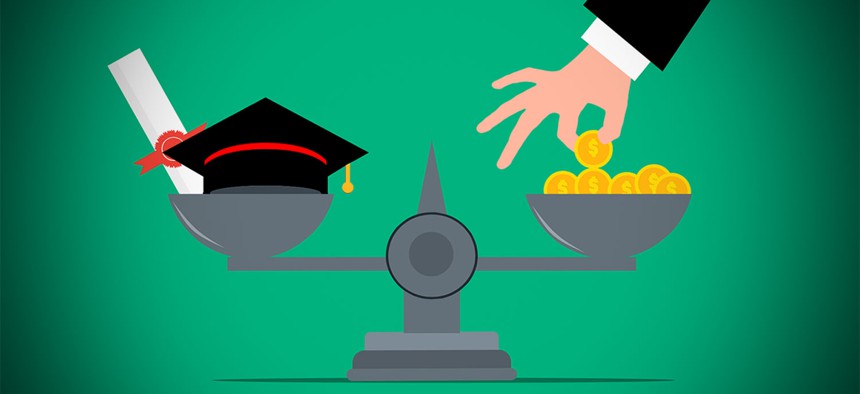The Public Service Loan Forgiveness Program Works… Sometimes
Readers share their experiences with the Education Department program that was recently overhauled. Challenges still remain, though the October changes did help many.
The Biden administration is reportedly mulling some form of broad-based student debt forgiveness. Such a program might be novel for the general public, but may look very familiar to many public servants, teachers and others involved in community service.
Introduced in 2007, the Public Service Loan Forgiveness program was designed to forgive student loan debt for borrowers who met certain criteria, including 10 years of qualifying payments while working for an eligible government or non-profit organization. The program, however, did not fulfill its full promise as originally designed. Issues and concerns about which public service careers were eligible created barriers to enrollment for many workers. Similarly, confusion and bureaucracy around the enrollment paperwork, loan servicing and other issues meant very few enrollees had successfully gotten their debt forgiven, even after making 120 on-time payments.
The Biden administration overhauled the program in the fall of 2021 to address these issues, opening the floodgates for applicants. More than 100,000 people have now had their loans forgiven through the program.
The success of the overhaul, and broader talk of loan forgiveness got us wondering just how difficult the PSLF red tape was for our readers. Many of you reached out with your stories of phone calls, check-ins, consolidations and worry. Every story was different. Some huddled with coworkers at their agencies to overcome obstacles, while others were Internet sleuths, checking every nook and cranny for any piece of information that could help. Borrowers told us their financial stories, from their interest rates to their first salaries in public service. Many of the stories reflected a familiar tale of miscommunication and frustration, while many also eventually got some clarity and, ultimately, relief.
One U.S. Agency for Global Media employee who requested anonymity said the program was an enticement to remain in her government job. “I stayed in the federal service because there was the carrot of having my loans forgiven,” she said in an email. But, she also recounted her paperwork delays, inconsistent instructions from the Education Department and her “bitter feelings” about the program.
“The Public Service Student Loan Forgiveness program is a joke,” she wrote.
It’s no secret that the cost of education is extremely high and public service jobs don’t usually pay well during the early parts of one’s career. Those with multiple or advanced degrees could be looking at hundreds of thousands of dollars in debt while working for less than their private sector colleagues.
Benyamin Margolis is a health scientist administrator with the Health and Human Services Department and holds multiple advanced degrees: a Ph.D., M.P.H., CHES, C.P.H. He estimates that his loans exceeded $150,000. He is still waiting for final forgiveness after submitting his paperwork and checking in with phone calls and emails. He is optimistic about being approved, but frustrated at the lengths he has had to travel to get to this place.
“The way that it was implemented was ... in a way to make it as impossible as possible to utilize,” he said of the PSLF. “I try my hardest to do a good job. I figured there has to be someone there eventually who is going to get things right.”
Christy Donahue emailed us with dates and forms she had filed in her 20 years of public service working for the Air Force, Defense Contract Audit Agency and Veterans Affairs Department. After applying for the program, she found herself trying to get clarity regularly on the phone and armed with extensive notes of previous conversations.
“I had all my notes,” she said. “I had a whole binder of information.”
Donahue’s career background as an auditor and her M.B.A.–she took out loans for her graduate degree–helped her, but she said that her persistence was more the determining factor in her getting approximately $30,000 of her $65,000 student debt forgiven.
“It doesn't matter that I have an MBA, but it does matter that I'm a little bit in the business mindset,” she said. “I was relentless.”
A lot of borrowers leaned on one another for information as to how to get things right within the overly complicated process. Angela Shade–now at the Food and Drug Administration–was working for the Veterans Affairs Department when she started looking into the program.
“We all checked in periodically with each other,” Shade said of her colleagues at VA. “Because we're like, ‘Okay, how's it going for you? What are you getting done?’ ”
Shade's loans were forgiven, as were the loans of most of those who told their stories. But, the process took a lot of time, effort and paperwork. Like most of those who emailed us, she had to be determined to get answers.
Donahue summed up her concerns about those who may not have the time or wherewithal to spend hours upon hours on the phone or send so many emails.
“[Getting the loans forgiven] was a huge burden lifted…It's unfortunate because everybody that's eligible should apply and should get it without having to do everything I did,” Donahue said. "A lot of people are in worse circumstances than I am."
What follows are just a few more of your responses to our request to share your loan forgiveness experiences, lightly edited for length and clarity.
You can hear more of the stories on Tuesday's episode of the GovExec Daily podcast.



